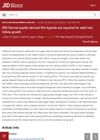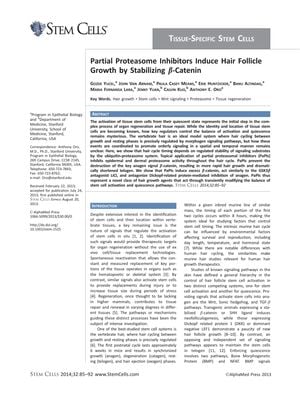TLDR Certain inhibitors applied to the skin can promote hair growth by maintaining a key hair growth signal.
The study demonstrated that the timing of hair growth cycles is influenced by the stability of signaling substrates regulated by the ubiquitin-proteasome system. Researchers found that applying partial proteasomal inhibitors (PaPIs) topically could inhibit proteasome activity in the skin, which in turn prevented the degradation of β-catenin, a crucial signal for the hair growth phase (anagen). This led to faster hair growth and a significantly shorter resting phase (telogen). The study revealed that PaPIs increase β-catenin levels, have a similar effect to the GSK3β antagonist LiCl, and counteract the inhibition of anagen by Dickopf-related protein. Consequently, PaPIs were identified as a new category of hair growth-promoting agents that work by temporarily altering the balance between stem cell activation and quiescence pathways.
218 citations
,
April 2008 in “Genes & Development” Skin stem cells help repair damage and maintain healthy skin.
4 citations
,
February 2008 in “Cell stem cell” 84 citations
,
January 2008 in “Cold Spring Harbor Symposia on Quantitative Biology” Skin stem cells help maintain skin health, grow hair, and heal wounds.
 829 citations
,
May 2007 in “Nature”
829 citations
,
May 2007 in “Nature” Hair follicles can regrow in wounded adult mouse skin using a process like embryo development.
71 citations
,
November 2005 in “The journal of investigative dermatology. Symposium proceedings/The Journal of investigative dermatology symposium proceedings” Edar signaling is crucial for proper hair follicle development and function.
1279 citations
,
November 2005 in “Nature Medicine”  231 citations
,
October 1999 in “Journal of Clinical Investigation”
231 citations
,
October 1999 in “Journal of Clinical Investigation” Activating the Sonic hedgehog gene in mice can start the hair growth phase.
 21 citations
,
May 2022 in “Frontiers in Cell and Developmental Biology”
21 citations
,
May 2022 in “Frontiers in Cell and Developmental Biology” Hair growth and health are influenced by factors like age, environment, and nutrition, and are controlled by various molecular pathways. Red light can promote hair growth, and understanding these processes can help treat hair-related diseases.
21 citations
,
May 2016 in “Experimental and Therapeutic Medicine” MMP-2 and MMP-9 help hair grow, while their inhibitors peak when hair growth slows.
 April 2016 in “Journal of Investigative Dermatology”
April 2016 in “Journal of Investigative Dermatology” Wnt ligands, produced by dermal papilla cells, are essential for adult hair growth and regeneration.
158 citations
,
February 2012 in “Journal of Investigative Dermatology” 95 citations
,
July 2006 in “British Journal of Dermatology” Vitamin D receptors in hair follicles change with the hair cycle, affecting hair growth.




